Aldi in China: Analyzing Marketing Strategies and Market Entry
VerifiedAdded on 2022/10/01
|10
|3292
|13
Case Study
AI Summary
This case study examines Aldi's international expansion, specifically focusing on its entry and marketing strategies in China. The report analyzes Aldi's initial entry strategy, which involved e-commerce before opening physical stores, highlighting the merits and shortcomings of this approach. It delves into the competitive environment, marketing tactics, and consumer behavior in China, including pricing, distribution, and promotional strategies. The study assesses Aldi's current situation in the Chinese market, its future strategies, and the challenges it faces, such as adapting to the fast-paced market and competition. The report emphasizes Aldi's core values of consistency, simplicity, and responsibility, and how they contribute to the company's success in the global retail landscape. Overall, the case study offers a comprehensive overview of Aldi's journey in China, providing valuable insights into market entry, marketing strategies, and the challenges of operating in a foreign market.
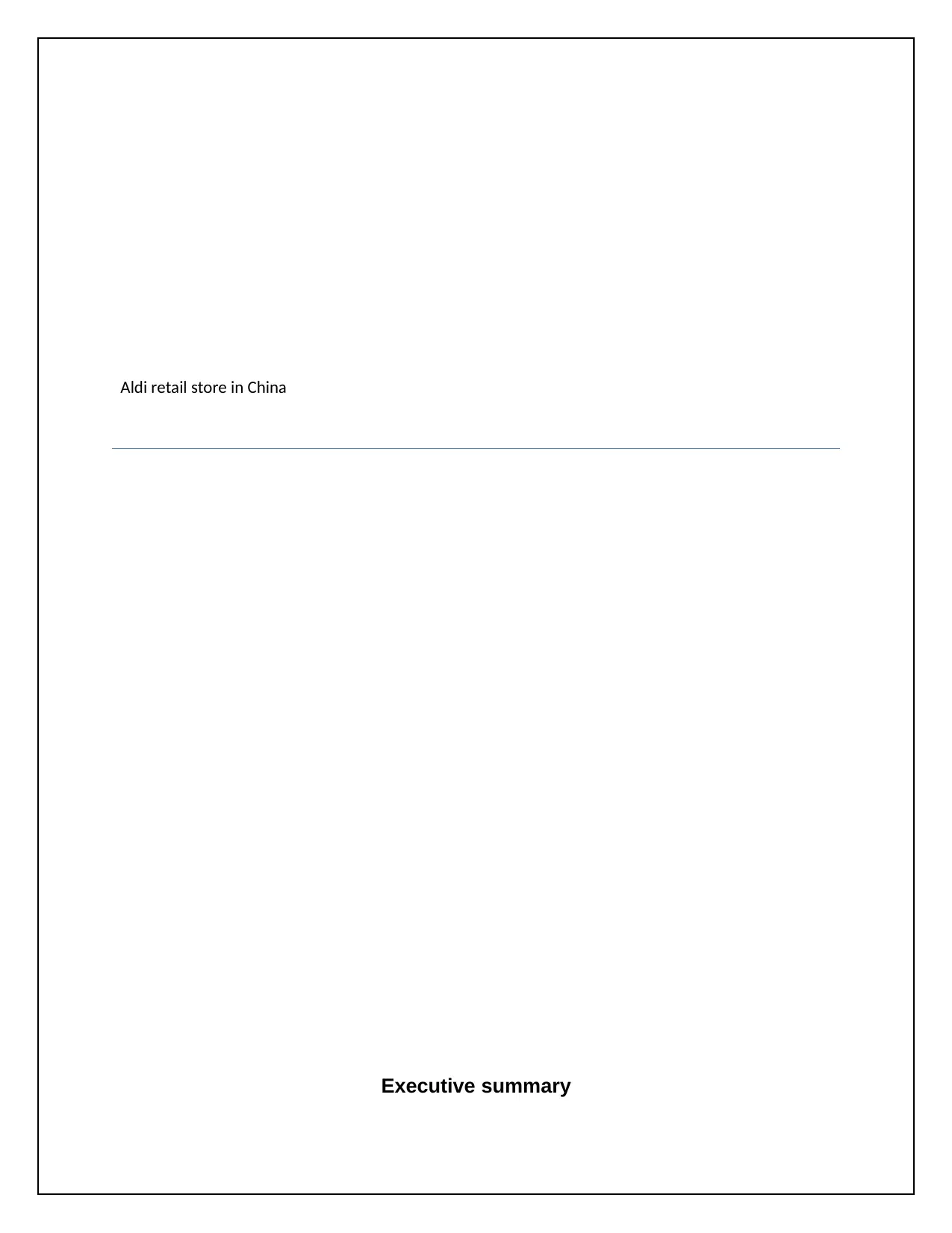
Aldi retail store in China
Executive summary
Executive summary
Paraphrase This Document
Need a fresh take? Get an instant paraphrase of this document with our AI Paraphraser
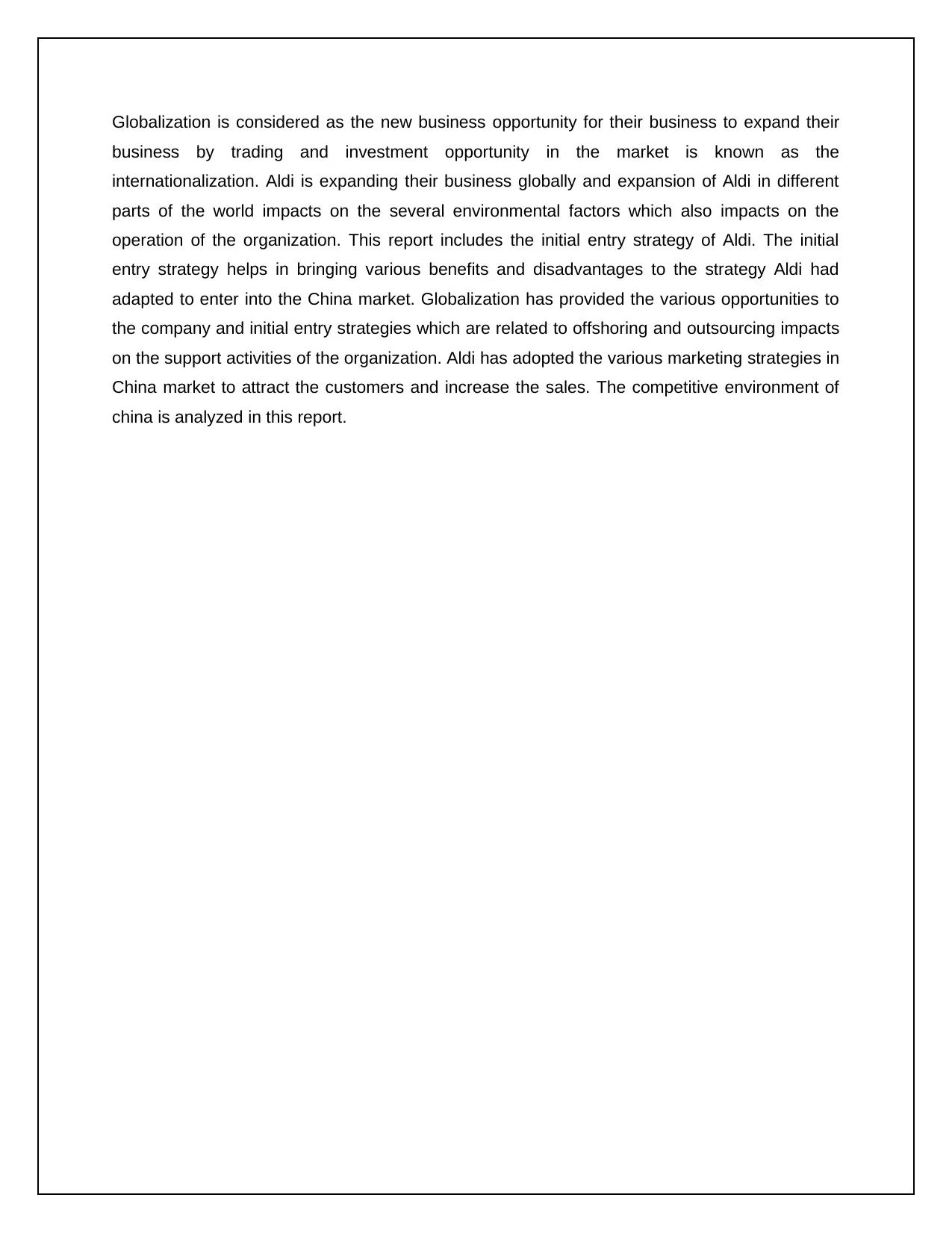
Globalization is considered as the new business opportunity for their business to expand their
business by trading and investment opportunity in the market is known as the
internationalization. Aldi is expanding their business globally and expansion of Aldi in different
parts of the world impacts on the several environmental factors which also impacts on the
operation of the organization. This report includes the initial entry strategy of Aldi. The initial
entry strategy helps in bringing various benefits and disadvantages to the strategy Aldi had
adapted to enter into the China market. Globalization has provided the various opportunities to
the company and initial entry strategies which are related to offshoring and outsourcing impacts
on the support activities of the organization. Aldi has adopted the various marketing strategies in
China market to attract the customers and increase the sales. The competitive environment of
china is analyzed in this report.
business by trading and investment opportunity in the market is known as the
internationalization. Aldi is expanding their business globally and expansion of Aldi in different
parts of the world impacts on the several environmental factors which also impacts on the
operation of the organization. This report includes the initial entry strategy of Aldi. The initial
entry strategy helps in bringing various benefits and disadvantages to the strategy Aldi had
adapted to enter into the China market. Globalization has provided the various opportunities to
the company and initial entry strategies which are related to offshoring and outsourcing impacts
on the support activities of the organization. Aldi has adopted the various marketing strategies in
China market to attract the customers and increase the sales. The competitive environment of
china is analyzed in this report.
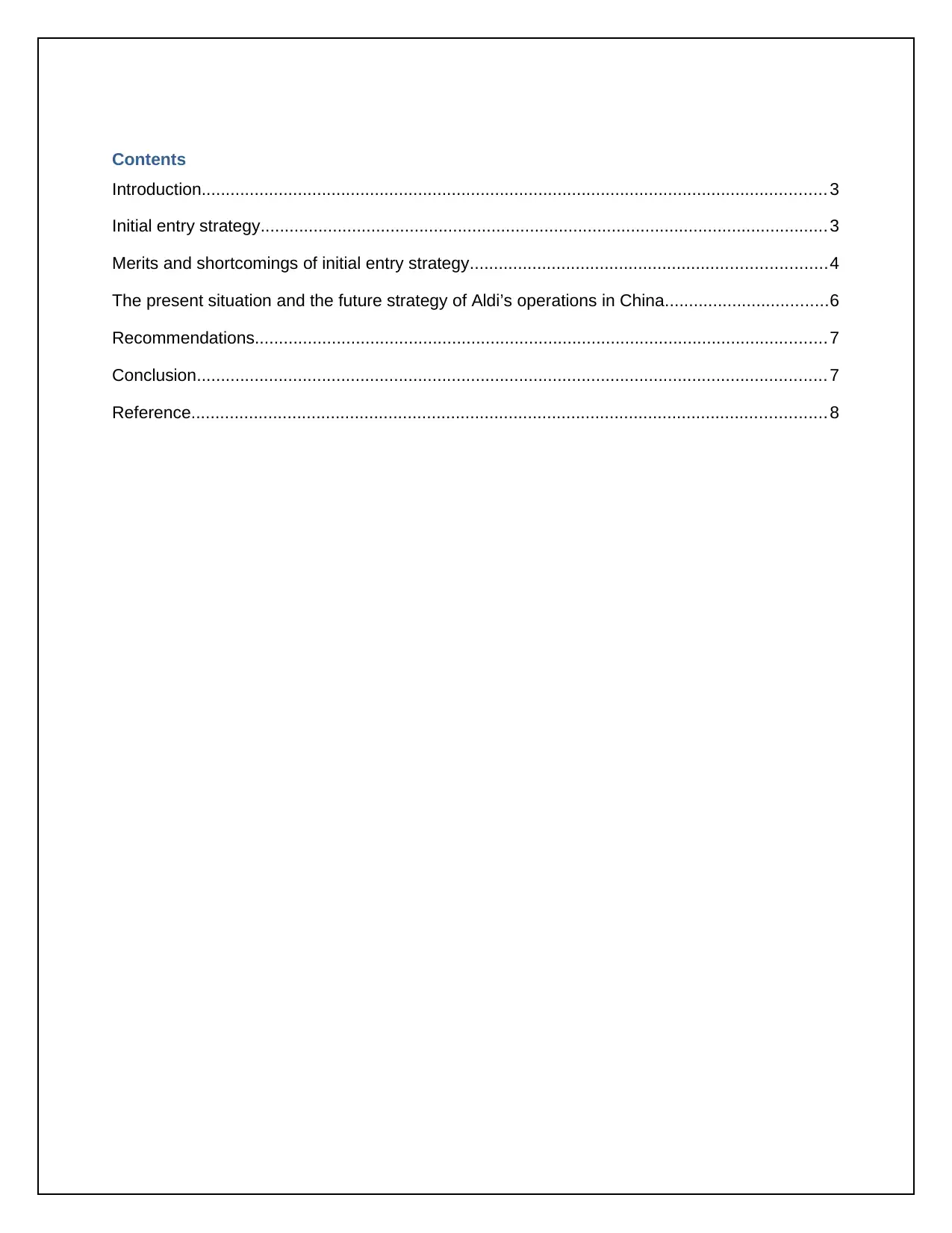
Contents
Introduction.................................................................................................................................. 3
Initial entry strategy...................................................................................................................... 3
Merits and shortcomings of initial entry strategy..........................................................................4
The present situation and the future strategy of Aldi’s operations in China..................................6
Recommendations....................................................................................................................... 7
Conclusion................................................................................................................................... 7
Reference.................................................................................................................................... 8
Introduction.................................................................................................................................. 3
Initial entry strategy...................................................................................................................... 3
Merits and shortcomings of initial entry strategy..........................................................................4
The present situation and the future strategy of Aldi’s operations in China..................................6
Recommendations....................................................................................................................... 7
Conclusion................................................................................................................................... 7
Reference.................................................................................................................................... 8
⊘ This is a preview!⊘
Do you want full access?
Subscribe today to unlock all pages.

Trusted by 1+ million students worldwide
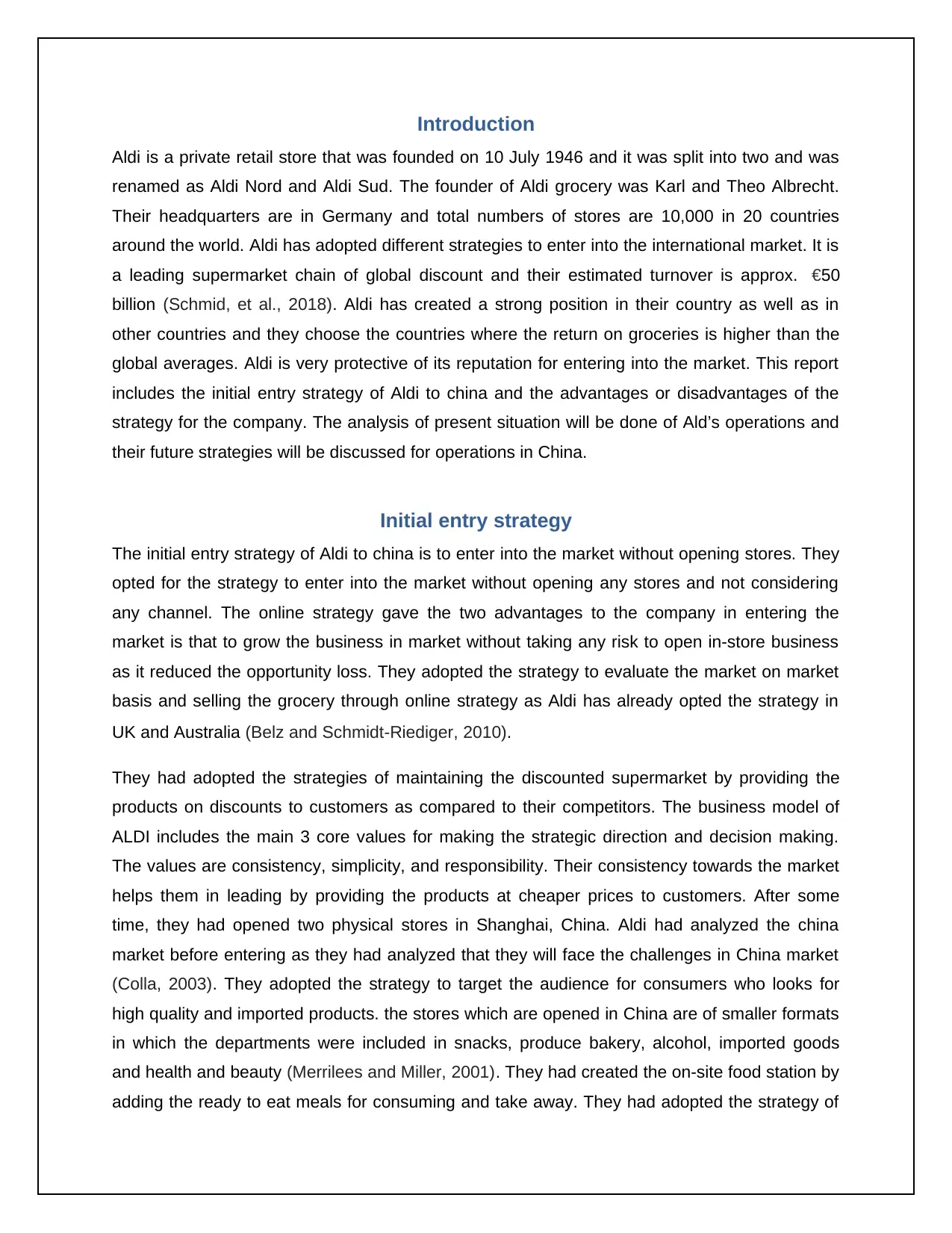
Introduction
Aldi is a private retail store that was founded on 10 July 1946 and it was split into two and was
renamed as Aldi Nord and Aldi Sud. The founder of Aldi grocery was Karl and Theo Albrecht.
Their headquarters are in Germany and total numbers of stores are 10,000 in 20 countries
around the world. Aldi has adopted different strategies to enter into the international market. It is
a leading supermarket chain of global discount and their estimated turnover is approx. €50
billion (Schmid, et al., 2018). Aldi has created a strong position in their country as well as in
other countries and they choose the countries where the return on groceries is higher than the
global averages. Aldi is very protective of its reputation for entering into the market. This report
includes the initial entry strategy of Aldi to china and the advantages or disadvantages of the
strategy for the company. The analysis of present situation will be done of Ald’s operations and
their future strategies will be discussed for operations in China.
Initial entry strategy
The initial entry strategy of Aldi to china is to enter into the market without opening stores. They
opted for the strategy to enter into the market without opening any stores and not considering
any channel. The online strategy gave the two advantages to the company in entering the
market is that to grow the business in market without taking any risk to open in-store business
as it reduced the opportunity loss. They adopted the strategy to evaluate the market on market
basis and selling the grocery through online strategy as Aldi has already opted the strategy in
UK and Australia (Belz and Schmidt‐Riediger, 2010).
They had adopted the strategies of maintaining the discounted supermarket by providing the
products on discounts to customers as compared to their competitors. The business model of
ALDI includes the main 3 core values for making the strategic direction and decision making.
The values are consistency, simplicity, and responsibility. Their consistency towards the market
helps them in leading by providing the products at cheaper prices to customers. After some
time, they had opened two physical stores in Shanghai, China. Aldi had analyzed the china
market before entering as they had analyzed that they will face the challenges in China market
(Colla, 2003). They adopted the strategy to target the audience for consumers who looks for
high quality and imported products. the stores which are opened in China are of smaller formats
in which the departments were included in snacks, produce bakery, alcohol, imported goods
and health and beauty (Merrilees and Miller, 2001). They had created the on-site food station by
adding the ready to eat meals for consuming and take away. They had adopted the strategy of
Aldi is a private retail store that was founded on 10 July 1946 and it was split into two and was
renamed as Aldi Nord and Aldi Sud. The founder of Aldi grocery was Karl and Theo Albrecht.
Their headquarters are in Germany and total numbers of stores are 10,000 in 20 countries
around the world. Aldi has adopted different strategies to enter into the international market. It is
a leading supermarket chain of global discount and their estimated turnover is approx. €50
billion (Schmid, et al., 2018). Aldi has created a strong position in their country as well as in
other countries and they choose the countries where the return on groceries is higher than the
global averages. Aldi is very protective of its reputation for entering into the market. This report
includes the initial entry strategy of Aldi to china and the advantages or disadvantages of the
strategy for the company. The analysis of present situation will be done of Ald’s operations and
their future strategies will be discussed for operations in China.
Initial entry strategy
The initial entry strategy of Aldi to china is to enter into the market without opening stores. They
opted for the strategy to enter into the market without opening any stores and not considering
any channel. The online strategy gave the two advantages to the company in entering the
market is that to grow the business in market without taking any risk to open in-store business
as it reduced the opportunity loss. They adopted the strategy to evaluate the market on market
basis and selling the grocery through online strategy as Aldi has already opted the strategy in
UK and Australia (Belz and Schmidt‐Riediger, 2010).
They had adopted the strategies of maintaining the discounted supermarket by providing the
products on discounts to customers as compared to their competitors. The business model of
ALDI includes the main 3 core values for making the strategic direction and decision making.
The values are consistency, simplicity, and responsibility. Their consistency towards the market
helps them in leading by providing the products at cheaper prices to customers. After some
time, they had opened two physical stores in Shanghai, China. Aldi had analyzed the china
market before entering as they had analyzed that they will face the challenges in China market
(Colla, 2003). They adopted the strategy to target the audience for consumers who looks for
high quality and imported products. the stores which are opened in China are of smaller formats
in which the departments were included in snacks, produce bakery, alcohol, imported goods
and health and beauty (Merrilees and Miller, 2001). They had created the on-site food station by
adding the ready to eat meals for consuming and take away. They had adopted the strategy of
Paraphrase This Document
Need a fresh take? Get an instant paraphrase of this document with our AI Paraphraser
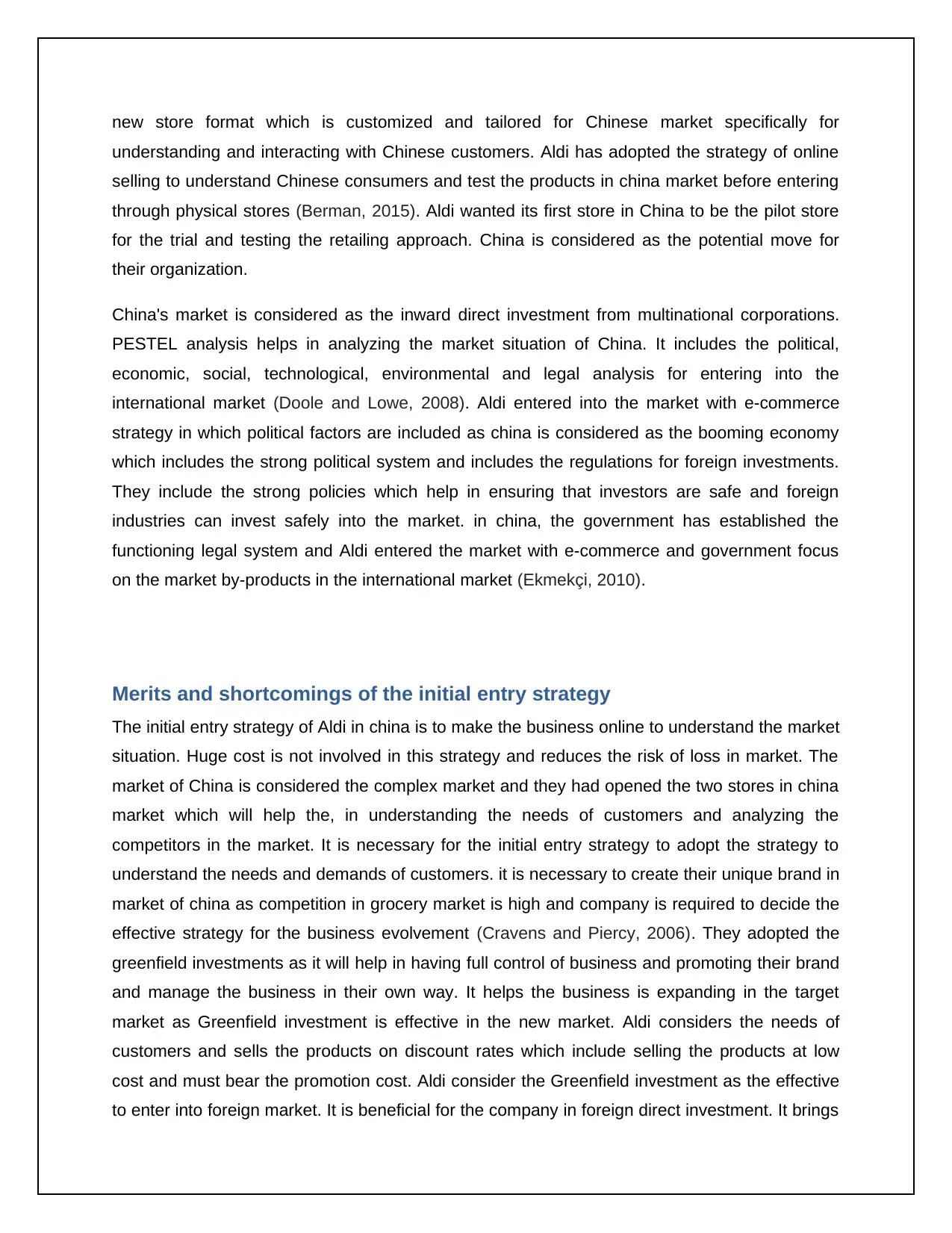
new store format which is customized and tailored for Chinese market specifically for
understanding and interacting with Chinese customers. Aldi has adopted the strategy of online
selling to understand Chinese consumers and test the products in china market before entering
through physical stores (Berman, 2015). Aldi wanted its first store in China to be the pilot store
for the trial and testing the retailing approach. China is considered as the potential move for
their organization.
China's market is considered as the inward direct investment from multinational corporations.
PESTEL analysis helps in analyzing the market situation of China. It includes the political,
economic, social, technological, environmental and legal analysis for entering into the
international market (Doole and Lowe, 2008). Aldi entered into the market with e-commerce
strategy in which political factors are included as china is considered as the booming economy
which includes the strong political system and includes the regulations for foreign investments.
They include the strong policies which help in ensuring that investors are safe and foreign
industries can invest safely into the market. in china, the government has established the
functioning legal system and Aldi entered the market with e-commerce and government focus
on the market by-products in the international market (Ekmekçi, 2010).
Merits and shortcomings of the initial entry strategy
The initial entry strategy of Aldi in china is to make the business online to understand the market
situation. Huge cost is not involved in this strategy and reduces the risk of loss in market. The
market of China is considered the complex market and they had opened the two stores in china
market which will help the, in understanding the needs of customers and analyzing the
competitors in the market. It is necessary for the initial entry strategy to adopt the strategy to
understand the needs and demands of customers. it is necessary to create their unique brand in
market of china as competition in grocery market is high and company is required to decide the
effective strategy for the business evolvement (Cravens and Piercy, 2006). They adopted the
greenfield investments as it will help in having full control of business and promoting their brand
and manage the business in their own way. It helps the business is expanding in the target
market as Greenfield investment is effective in the new market. Aldi considers the needs of
customers and sells the products on discount rates which include selling the products at low
cost and must bear the promotion cost. Aldi consider the Greenfield investment as the effective
to enter into foreign market. It is beneficial for the company in foreign direct investment. It brings
understanding and interacting with Chinese customers. Aldi has adopted the strategy of online
selling to understand Chinese consumers and test the products in china market before entering
through physical stores (Berman, 2015). Aldi wanted its first store in China to be the pilot store
for the trial and testing the retailing approach. China is considered as the potential move for
their organization.
China's market is considered as the inward direct investment from multinational corporations.
PESTEL analysis helps in analyzing the market situation of China. It includes the political,
economic, social, technological, environmental and legal analysis for entering into the
international market (Doole and Lowe, 2008). Aldi entered into the market with e-commerce
strategy in which political factors are included as china is considered as the booming economy
which includes the strong political system and includes the regulations for foreign investments.
They include the strong policies which help in ensuring that investors are safe and foreign
industries can invest safely into the market. in china, the government has established the
functioning legal system and Aldi entered the market with e-commerce and government focus
on the market by-products in the international market (Ekmekçi, 2010).
Merits and shortcomings of the initial entry strategy
The initial entry strategy of Aldi in china is to make the business online to understand the market
situation. Huge cost is not involved in this strategy and reduces the risk of loss in market. The
market of China is considered the complex market and they had opened the two stores in china
market which will help the, in understanding the needs of customers and analyzing the
competitors in the market. It is necessary for the initial entry strategy to adopt the strategy to
understand the needs and demands of customers. it is necessary to create their unique brand in
market of china as competition in grocery market is high and company is required to decide the
effective strategy for the business evolvement (Cravens and Piercy, 2006). They adopted the
greenfield investments as it will help in having full control of business and promoting their brand
and manage the business in their own way. It helps the business is expanding in the target
market as Greenfield investment is effective in the new market. Aldi considers the needs of
customers and sells the products on discount rates which include selling the products at low
cost and must bear the promotion cost. Aldi consider the Greenfield investment as the effective
to enter into foreign market. It is beneficial for the company in foreign direct investment. It brings
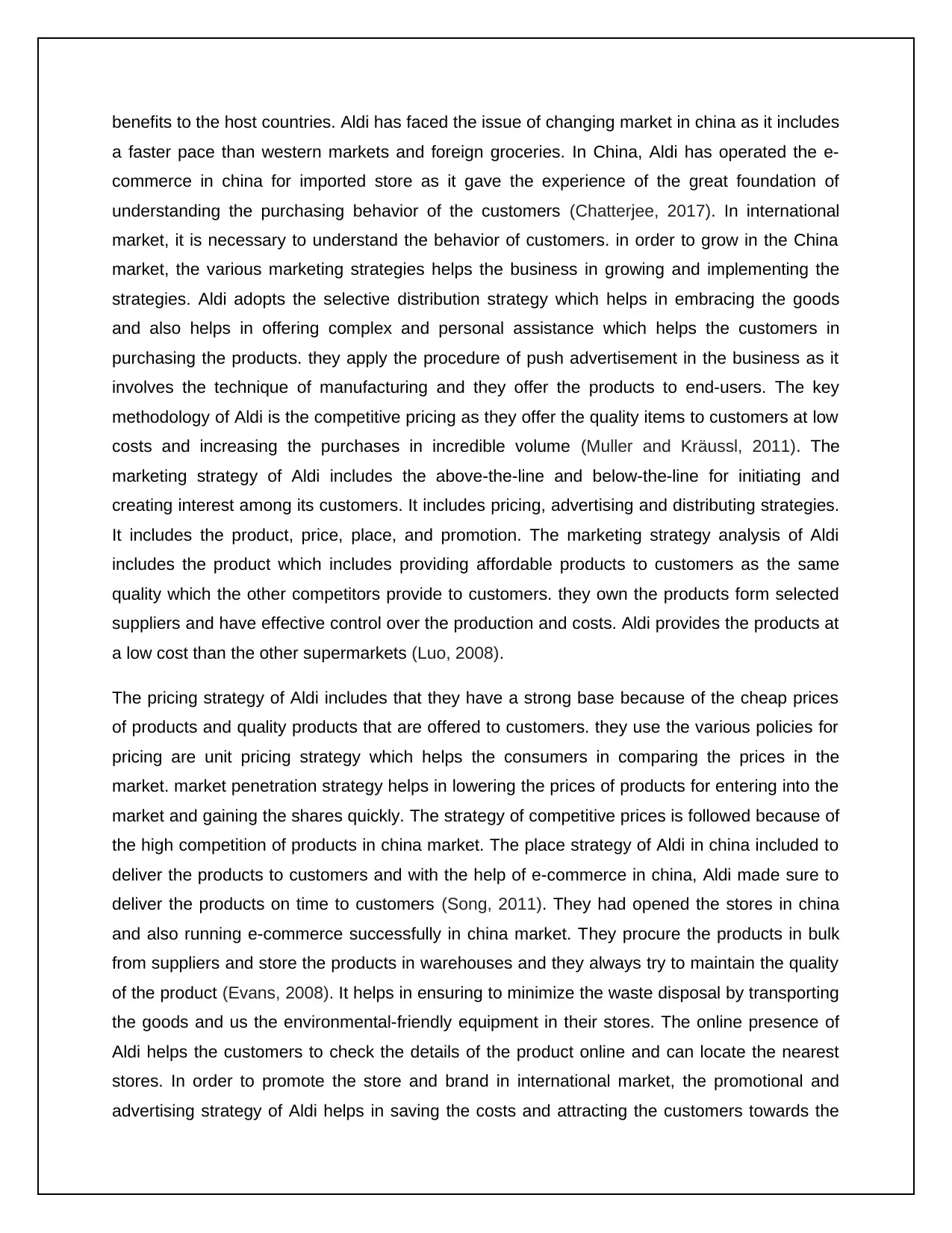
benefits to the host countries. Aldi has faced the issue of changing market in china as it includes
a faster pace than western markets and foreign groceries. In China, Aldi has operated the e-
commerce in china for imported store as it gave the experience of the great foundation of
understanding the purchasing behavior of the customers (Chatterjee, 2017). In international
market, it is necessary to understand the behavior of customers. in order to grow in the China
market, the various marketing strategies helps the business in growing and implementing the
strategies. Aldi adopts the selective distribution strategy which helps in embracing the goods
and also helps in offering complex and personal assistance which helps the customers in
purchasing the products. they apply the procedure of push advertisement in the business as it
involves the technique of manufacturing and they offer the products to end-users. The key
methodology of Aldi is the competitive pricing as they offer the quality items to customers at low
costs and increasing the purchases in incredible volume (Muller and Kräussl, 2011). The
marketing strategy of Aldi includes the above-the-line and below-the-line for initiating and
creating interest among its customers. It includes pricing, advertising and distributing strategies.
It includes the product, price, place, and promotion. The marketing strategy analysis of Aldi
includes the product which includes providing affordable products to customers as the same
quality which the other competitors provide to customers. they own the products form selected
suppliers and have effective control over the production and costs. Aldi provides the products at
a low cost than the other supermarkets (Luo, 2008).
The pricing strategy of Aldi includes that they have a strong base because of the cheap prices
of products and quality products that are offered to customers. they use the various policies for
pricing are unit pricing strategy which helps the consumers in comparing the prices in the
market. market penetration strategy helps in lowering the prices of products for entering into the
market and gaining the shares quickly. The strategy of competitive prices is followed because of
the high competition of products in china market. The place strategy of Aldi in china included to
deliver the products to customers and with the help of e-commerce in china, Aldi made sure to
deliver the products on time to customers (Song, 2011). They had opened the stores in china
and also running e-commerce successfully in china market. They procure the products in bulk
from suppliers and store the products in warehouses and they always try to maintain the quality
of the product (Evans, 2008). It helps in ensuring to minimize the waste disposal by transporting
the goods and us the environmental-friendly equipment in their stores. The online presence of
Aldi helps the customers to check the details of the product online and can locate the nearest
stores. In order to promote the store and brand in international market, the promotional and
advertising strategy of Aldi helps in saving the costs and attracting the customers towards the
a faster pace than western markets and foreign groceries. In China, Aldi has operated the e-
commerce in china for imported store as it gave the experience of the great foundation of
understanding the purchasing behavior of the customers (Chatterjee, 2017). In international
market, it is necessary to understand the behavior of customers. in order to grow in the China
market, the various marketing strategies helps the business in growing and implementing the
strategies. Aldi adopts the selective distribution strategy which helps in embracing the goods
and also helps in offering complex and personal assistance which helps the customers in
purchasing the products. they apply the procedure of push advertisement in the business as it
involves the technique of manufacturing and they offer the products to end-users. The key
methodology of Aldi is the competitive pricing as they offer the quality items to customers at low
costs and increasing the purchases in incredible volume (Muller and Kräussl, 2011). The
marketing strategy of Aldi includes the above-the-line and below-the-line for initiating and
creating interest among its customers. It includes pricing, advertising and distributing strategies.
It includes the product, price, place, and promotion. The marketing strategy analysis of Aldi
includes the product which includes providing affordable products to customers as the same
quality which the other competitors provide to customers. they own the products form selected
suppliers and have effective control over the production and costs. Aldi provides the products at
a low cost than the other supermarkets (Luo, 2008).
The pricing strategy of Aldi includes that they have a strong base because of the cheap prices
of products and quality products that are offered to customers. they use the various policies for
pricing are unit pricing strategy which helps the consumers in comparing the prices in the
market. market penetration strategy helps in lowering the prices of products for entering into the
market and gaining the shares quickly. The strategy of competitive prices is followed because of
the high competition of products in china market. The place strategy of Aldi in china included to
deliver the products to customers and with the help of e-commerce in china, Aldi made sure to
deliver the products on time to customers (Song, 2011). They had opened the stores in china
and also running e-commerce successfully in china market. They procure the products in bulk
from suppliers and store the products in warehouses and they always try to maintain the quality
of the product (Evans, 2008). It helps in ensuring to minimize the waste disposal by transporting
the goods and us the environmental-friendly equipment in their stores. The online presence of
Aldi helps the customers to check the details of the product online and can locate the nearest
stores. In order to promote the store and brand in international market, the promotional and
advertising strategy of Aldi helps in saving the costs and attracting the customers towards the
⊘ This is a preview!⊘
Do you want full access?
Subscribe today to unlock all pages.

Trusted by 1+ million students worldwide
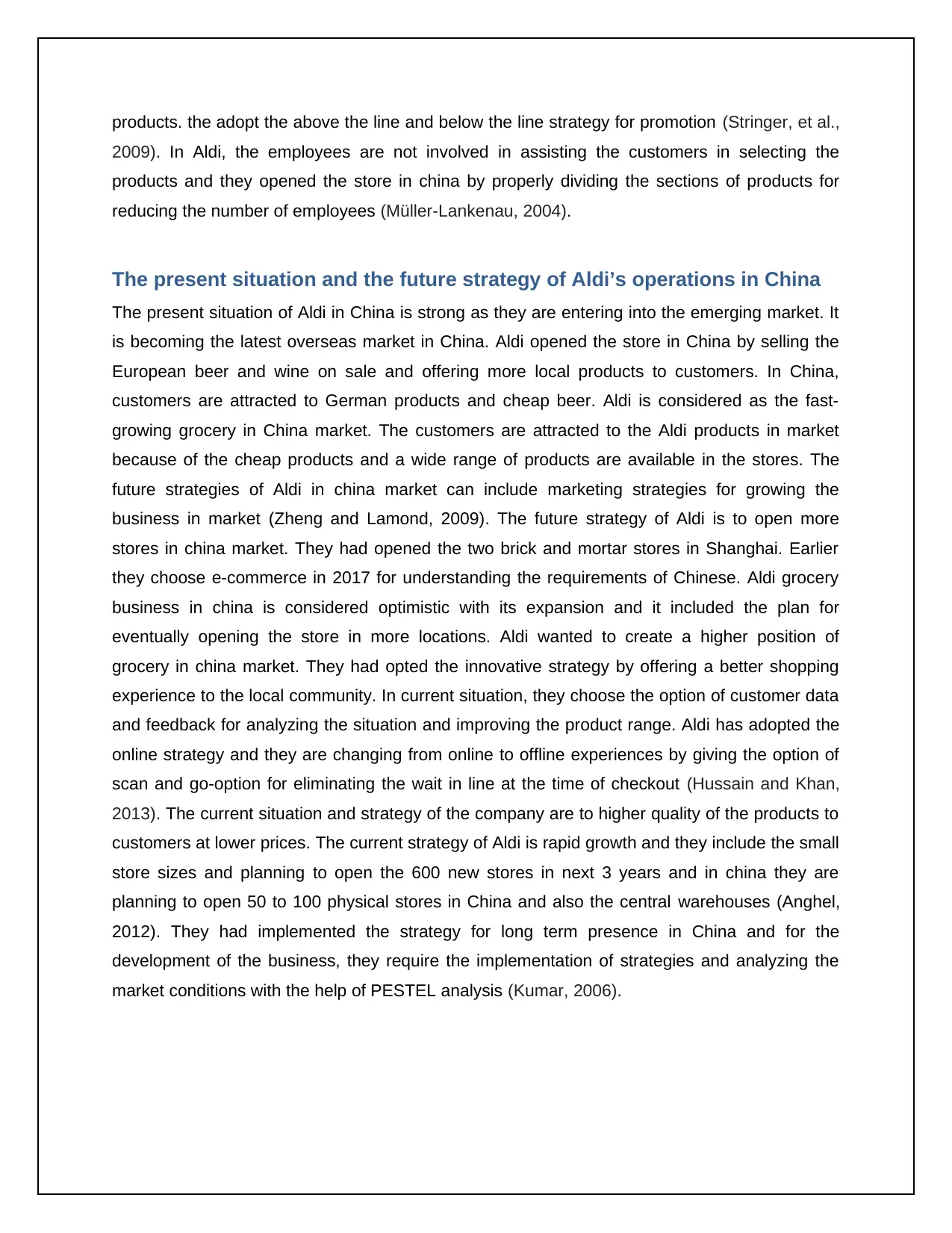
products. the adopt the above the line and below the line strategy for promotion (Stringer, et al.,
2009). In Aldi, the employees are not involved in assisting the customers in selecting the
products and they opened the store in china by properly dividing the sections of products for
reducing the number of employees (Müller-Lankenau, 2004).
The present situation and the future strategy of Aldi’s operations in China
The present situation of Aldi in China is strong as they are entering into the emerging market. It
is becoming the latest overseas market in China. Aldi opened the store in China by selling the
European beer and wine on sale and offering more local products to customers. In China,
customers are attracted to German products and cheap beer. Aldi is considered as the fast-
growing grocery in China market. The customers are attracted to the Aldi products in market
because of the cheap products and a wide range of products are available in the stores. The
future strategies of Aldi in china market can include marketing strategies for growing the
business in market (Zheng and Lamond, 2009). The future strategy of Aldi is to open more
stores in china market. They had opened the two brick and mortar stores in Shanghai. Earlier
they choose e-commerce in 2017 for understanding the requirements of Chinese. Aldi grocery
business in china is considered optimistic with its expansion and it included the plan for
eventually opening the store in more locations. Aldi wanted to create a higher position of
grocery in china market. They had opted the innovative strategy by offering a better shopping
experience to the local community. In current situation, they choose the option of customer data
and feedback for analyzing the situation and improving the product range. Aldi has adopted the
online strategy and they are changing from online to offline experiences by giving the option of
scan and go-option for eliminating the wait in line at the time of checkout (Hussain and Khan,
2013). The current situation and strategy of the company are to higher quality of the products to
customers at lower prices. The current strategy of Aldi is rapid growth and they include the small
store sizes and planning to open the 600 new stores in next 3 years and in china they are
planning to open 50 to 100 physical stores in China and also the central warehouses (Anghel,
2012). They had implemented the strategy for long term presence in China and for the
development of the business, they require the implementation of strategies and analyzing the
market conditions with the help of PESTEL analysis (Kumar, 2006).
2009). In Aldi, the employees are not involved in assisting the customers in selecting the
products and they opened the store in china by properly dividing the sections of products for
reducing the number of employees (Müller-Lankenau, 2004).
The present situation and the future strategy of Aldi’s operations in China
The present situation of Aldi in China is strong as they are entering into the emerging market. It
is becoming the latest overseas market in China. Aldi opened the store in China by selling the
European beer and wine on sale and offering more local products to customers. In China,
customers are attracted to German products and cheap beer. Aldi is considered as the fast-
growing grocery in China market. The customers are attracted to the Aldi products in market
because of the cheap products and a wide range of products are available in the stores. The
future strategies of Aldi in china market can include marketing strategies for growing the
business in market (Zheng and Lamond, 2009). The future strategy of Aldi is to open more
stores in china market. They had opened the two brick and mortar stores in Shanghai. Earlier
they choose e-commerce in 2017 for understanding the requirements of Chinese. Aldi grocery
business in china is considered optimistic with its expansion and it included the plan for
eventually opening the store in more locations. Aldi wanted to create a higher position of
grocery in china market. They had opted the innovative strategy by offering a better shopping
experience to the local community. In current situation, they choose the option of customer data
and feedback for analyzing the situation and improving the product range. Aldi has adopted the
online strategy and they are changing from online to offline experiences by giving the option of
scan and go-option for eliminating the wait in line at the time of checkout (Hussain and Khan,
2013). The current situation and strategy of the company are to higher quality of the products to
customers at lower prices. The current strategy of Aldi is rapid growth and they include the small
store sizes and planning to open the 600 new stores in next 3 years and in china they are
planning to open 50 to 100 physical stores in China and also the central warehouses (Anghel,
2012). They had implemented the strategy for long term presence in China and for the
development of the business, they require the implementation of strategies and analyzing the
market conditions with the help of PESTEL analysis (Kumar, 2006).
Paraphrase This Document
Need a fresh take? Get an instant paraphrase of this document with our AI Paraphraser
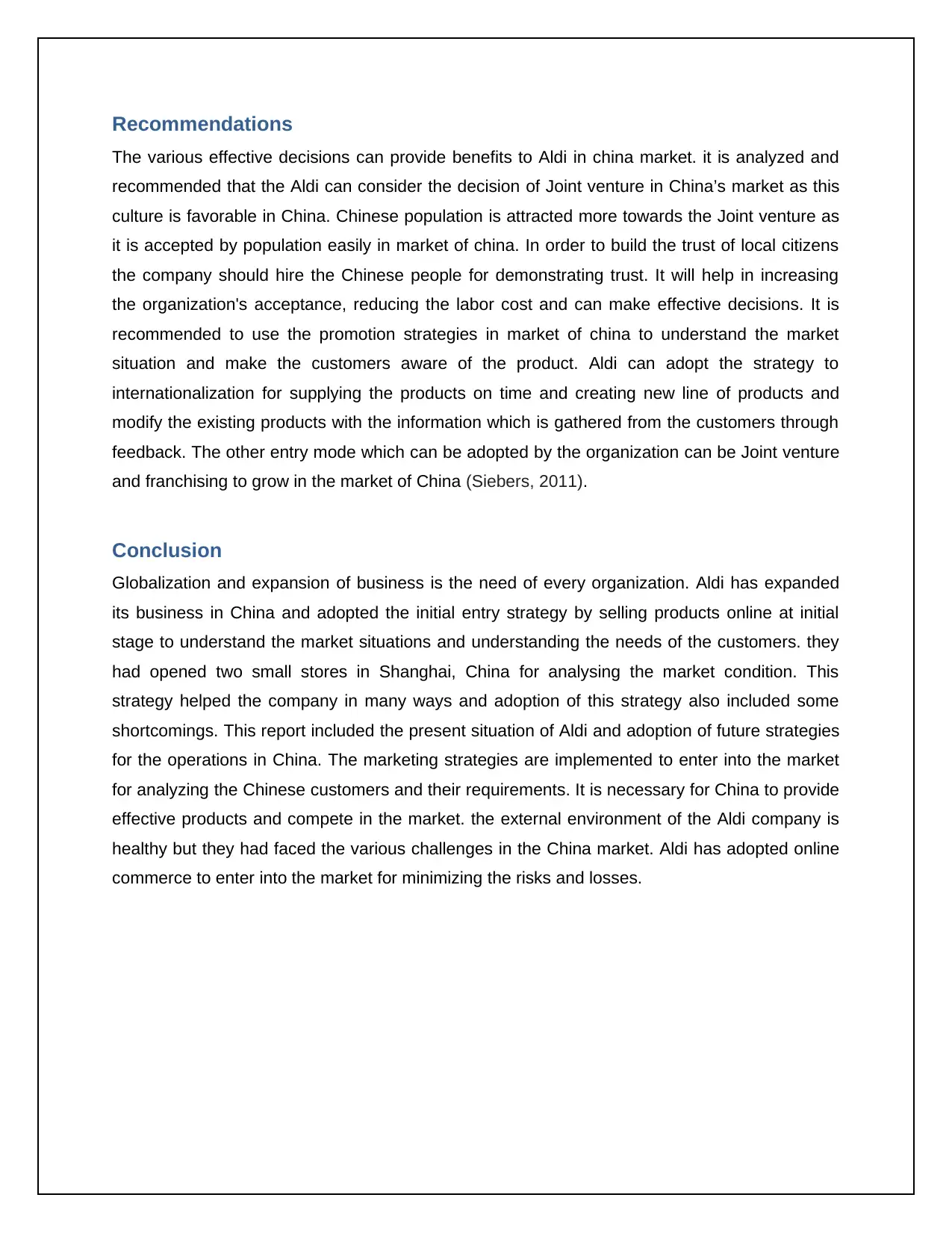
Recommendations
The various effective decisions can provide benefits to Aldi in china market. it is analyzed and
recommended that the Aldi can consider the decision of Joint venture in China’s market as this
culture is favorable in China. Chinese population is attracted more towards the Joint venture as
it is accepted by population easily in market of china. In order to build the trust of local citizens
the company should hire the Chinese people for demonstrating trust. It will help in increasing
the organization's acceptance, reducing the labor cost and can make effective decisions. It is
recommended to use the promotion strategies in market of china to understand the market
situation and make the customers aware of the product. Aldi can adopt the strategy to
internationalization for supplying the products on time and creating new line of products and
modify the existing products with the information which is gathered from the customers through
feedback. The other entry mode which can be adopted by the organization can be Joint venture
and franchising to grow in the market of China (Siebers, 2011).
Conclusion
Globalization and expansion of business is the need of every organization. Aldi has expanded
its business in China and adopted the initial entry strategy by selling products online at initial
stage to understand the market situations and understanding the needs of the customers. they
had opened two small stores in Shanghai, China for analysing the market condition. This
strategy helped the company in many ways and adoption of this strategy also included some
shortcomings. This report included the present situation of Aldi and adoption of future strategies
for the operations in China. The marketing strategies are implemented to enter into the market
for analyzing the Chinese customers and their requirements. It is necessary for China to provide
effective products and compete in the market. the external environment of the Aldi company is
healthy but they had faced the various challenges in the China market. Aldi has adopted online
commerce to enter into the market for minimizing the risks and losses.
The various effective decisions can provide benefits to Aldi in china market. it is analyzed and
recommended that the Aldi can consider the decision of Joint venture in China’s market as this
culture is favorable in China. Chinese population is attracted more towards the Joint venture as
it is accepted by population easily in market of china. In order to build the trust of local citizens
the company should hire the Chinese people for demonstrating trust. It will help in increasing
the organization's acceptance, reducing the labor cost and can make effective decisions. It is
recommended to use the promotion strategies in market of china to understand the market
situation and make the customers aware of the product. Aldi can adopt the strategy to
internationalization for supplying the products on time and creating new line of products and
modify the existing products with the information which is gathered from the customers through
feedback. The other entry mode which can be adopted by the organization can be Joint venture
and franchising to grow in the market of China (Siebers, 2011).
Conclusion
Globalization and expansion of business is the need of every organization. Aldi has expanded
its business in China and adopted the initial entry strategy by selling products online at initial
stage to understand the market situations and understanding the needs of the customers. they
had opened two small stores in Shanghai, China for analysing the market condition. This
strategy helped the company in many ways and adoption of this strategy also included some
shortcomings. This report included the present situation of Aldi and adoption of future strategies
for the operations in China. The marketing strategies are implemented to enter into the market
for analyzing the Chinese customers and their requirements. It is necessary for China to provide
effective products and compete in the market. the external environment of the Aldi company is
healthy but they had faced the various challenges in the China market. Aldi has adopted online
commerce to enter into the market for minimizing the risks and losses.
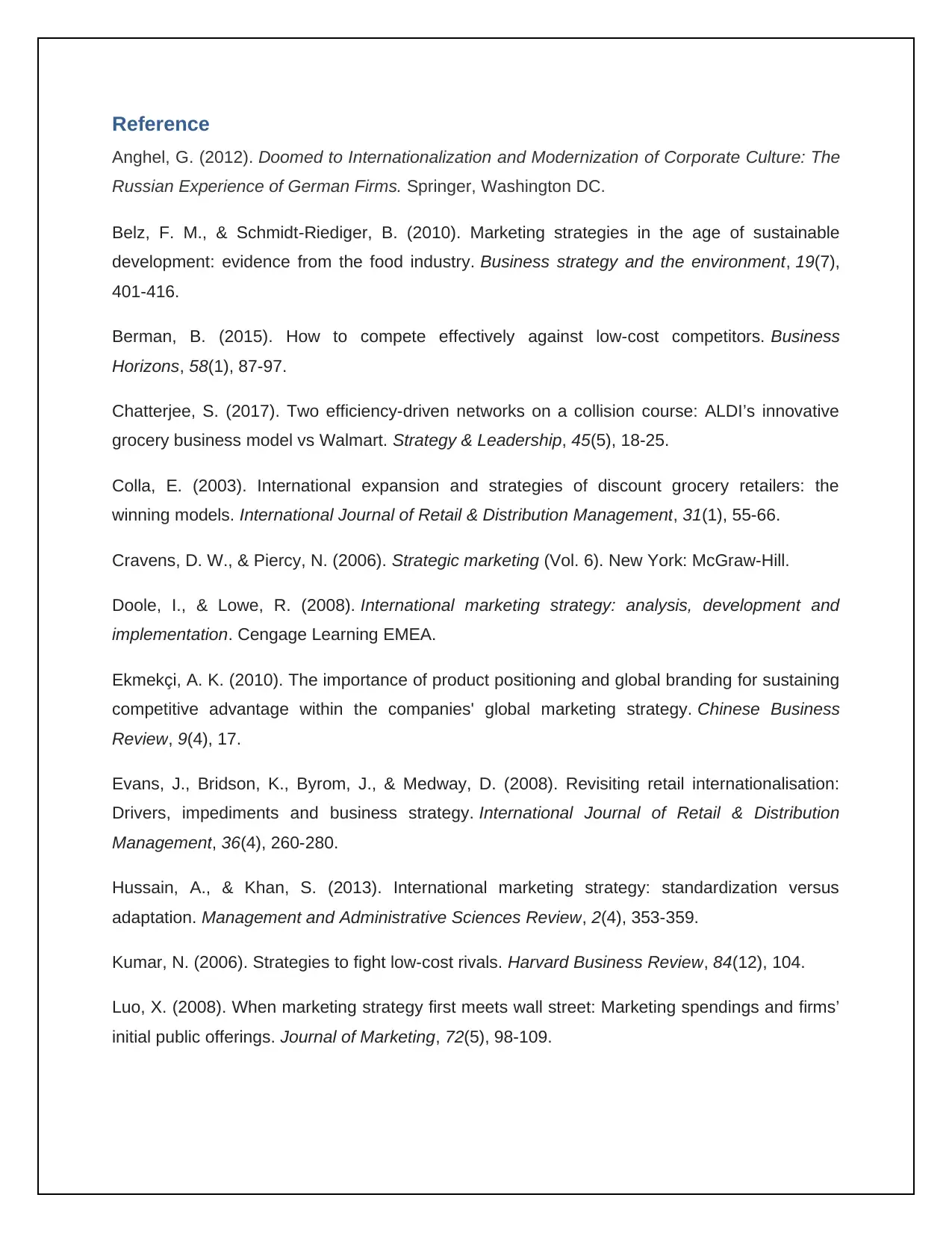
Reference
Anghel, G. (2012). Doomed to Internationalization and Modernization of Corporate Culture: The
Russian Experience of German Firms. Springer, Washington DC.
Belz, F. M., & Schmidt‐Riediger, B. (2010). Marketing strategies in the age of sustainable
development: evidence from the food industry. Business strategy and the environment, 19(7),
401-416.
Berman, B. (2015). How to compete effectively against low-cost competitors. Business
Horizons, 58(1), 87-97.
Chatterjee, S. (2017). Two efficiency-driven networks on a collision course: ALDI’s innovative
grocery business model vs Walmart. Strategy & Leadership, 45(5), 18-25.
Colla, E. (2003). International expansion and strategies of discount grocery retailers: the
winning models. International Journal of Retail & Distribution Management, 31(1), 55-66.
Cravens, D. W., & Piercy, N. (2006). Strategic marketing (Vol. 6). New York: McGraw-Hill.
Doole, I., & Lowe, R. (2008). International marketing strategy: analysis, development and
implementation. Cengage Learning EMEA.
Ekmekçi, A. K. (2010). The importance of product positioning and global branding for sustaining
competitive advantage within the companies' global marketing strategy. Chinese Business
Review, 9(4), 17.
Evans, J., Bridson, K., Byrom, J., & Medway, D. (2008). Revisiting retail internationalisation:
Drivers, impediments and business strategy. International Journal of Retail & Distribution
Management, 36(4), 260-280.
Hussain, A., & Khan, S. (2013). International marketing strategy: standardization versus
adaptation. Management and Administrative Sciences Review, 2(4), 353-359.
Kumar, N. (2006). Strategies to fight low-cost rivals. Harvard Business Review, 84(12), 104.
Luo, X. (2008). When marketing strategy first meets wall street: Marketing spendings and firms’
initial public offerings. Journal of Marketing, 72(5), 98-109.
Anghel, G. (2012). Doomed to Internationalization and Modernization of Corporate Culture: The
Russian Experience of German Firms. Springer, Washington DC.
Belz, F. M., & Schmidt‐Riediger, B. (2010). Marketing strategies in the age of sustainable
development: evidence from the food industry. Business strategy and the environment, 19(7),
401-416.
Berman, B. (2015). How to compete effectively against low-cost competitors. Business
Horizons, 58(1), 87-97.
Chatterjee, S. (2017). Two efficiency-driven networks on a collision course: ALDI’s innovative
grocery business model vs Walmart. Strategy & Leadership, 45(5), 18-25.
Colla, E. (2003). International expansion and strategies of discount grocery retailers: the
winning models. International Journal of Retail & Distribution Management, 31(1), 55-66.
Cravens, D. W., & Piercy, N. (2006). Strategic marketing (Vol. 6). New York: McGraw-Hill.
Doole, I., & Lowe, R. (2008). International marketing strategy: analysis, development and
implementation. Cengage Learning EMEA.
Ekmekçi, A. K. (2010). The importance of product positioning and global branding for sustaining
competitive advantage within the companies' global marketing strategy. Chinese Business
Review, 9(4), 17.
Evans, J., Bridson, K., Byrom, J., & Medway, D. (2008). Revisiting retail internationalisation:
Drivers, impediments and business strategy. International Journal of Retail & Distribution
Management, 36(4), 260-280.
Hussain, A., & Khan, S. (2013). International marketing strategy: standardization versus
adaptation. Management and Administrative Sciences Review, 2(4), 353-359.
Kumar, N. (2006). Strategies to fight low-cost rivals. Harvard Business Review, 84(12), 104.
Luo, X. (2008). When marketing strategy first meets wall street: Marketing spendings and firms’
initial public offerings. Journal of Marketing, 72(5), 98-109.
⊘ This is a preview!⊘
Do you want full access?
Subscribe today to unlock all pages.

Trusted by 1+ million students worldwide
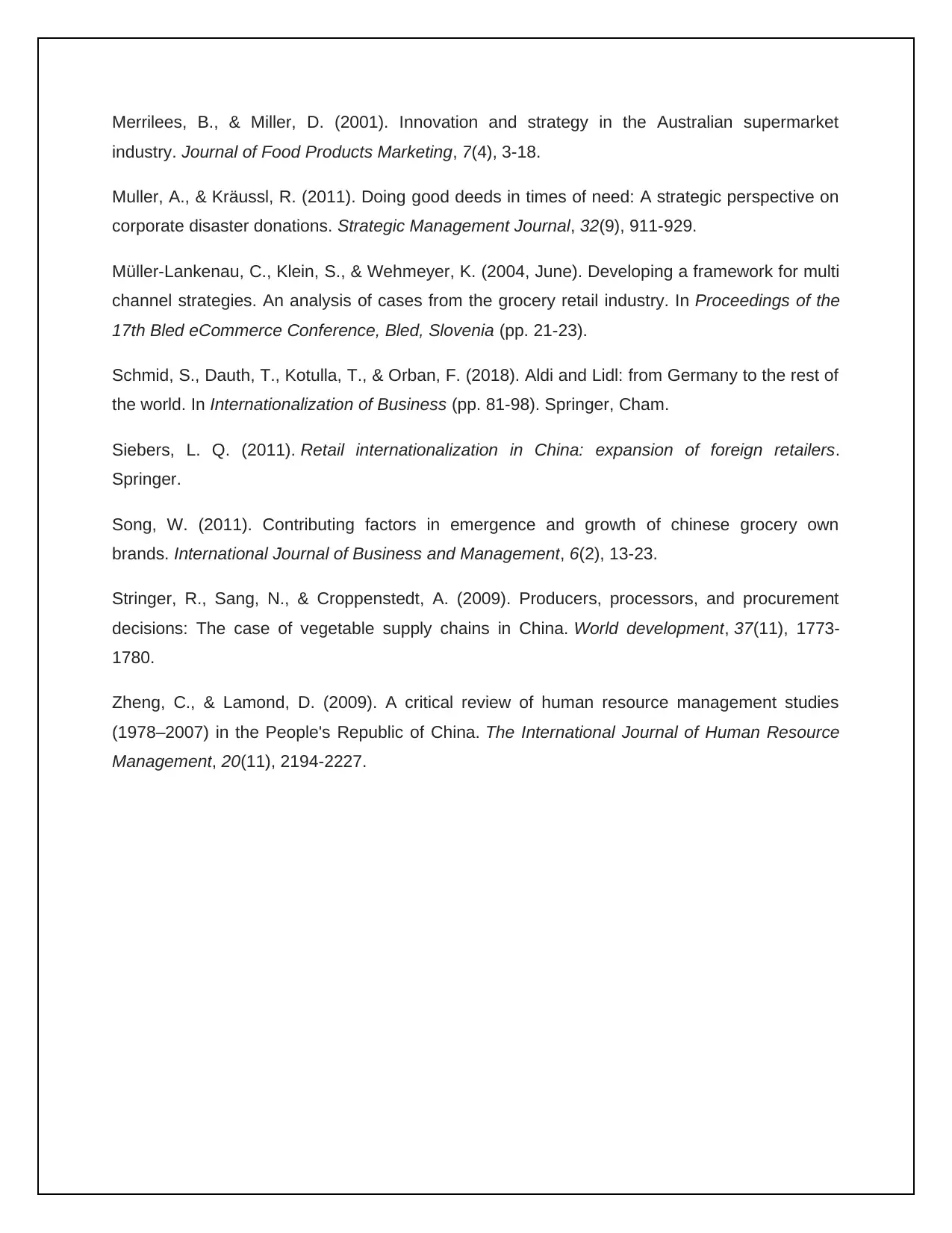
Merrilees, B., & Miller, D. (2001). Innovation and strategy in the Australian supermarket
industry. Journal of Food Products Marketing, 7(4), 3-18.
Muller, A., & Kräussl, R. (2011). Doing good deeds in times of need: A strategic perspective on
corporate disaster donations. Strategic Management Journal, 32(9), 911-929.
Müller-Lankenau, C., Klein, S., & Wehmeyer, K. (2004, June). Developing a framework for multi
channel strategies. An analysis of cases from the grocery retail industry. In Proceedings of the
17th Bled eCommerce Conference, Bled, Slovenia (pp. 21-23).
Schmid, S., Dauth, T., Kotulla, T., & Orban, F. (2018). Aldi and Lidl: from Germany to the rest of
the world. In Internationalization of Business (pp. 81-98). Springer, Cham.
Siebers, L. Q. (2011). Retail internationalization in China: expansion of foreign retailers.
Springer.
Song, W. (2011). Contributing factors in emergence and growth of chinese grocery own
brands. International Journal of Business and Management, 6(2), 13-23.
Stringer, R., Sang, N., & Croppenstedt, A. (2009). Producers, processors, and procurement
decisions: The case of vegetable supply chains in China. World development, 37(11), 1773-
1780.
Zheng, C., & Lamond, D. (2009). A critical review of human resource management studies
(1978–2007) in the People's Republic of China. The International Journal of Human Resource
Management, 20(11), 2194-2227.
industry. Journal of Food Products Marketing, 7(4), 3-18.
Muller, A., & Kräussl, R. (2011). Doing good deeds in times of need: A strategic perspective on
corporate disaster donations. Strategic Management Journal, 32(9), 911-929.
Müller-Lankenau, C., Klein, S., & Wehmeyer, K. (2004, June). Developing a framework for multi
channel strategies. An analysis of cases from the grocery retail industry. In Proceedings of the
17th Bled eCommerce Conference, Bled, Slovenia (pp. 21-23).
Schmid, S., Dauth, T., Kotulla, T., & Orban, F. (2018). Aldi and Lidl: from Germany to the rest of
the world. In Internationalization of Business (pp. 81-98). Springer, Cham.
Siebers, L. Q. (2011). Retail internationalization in China: expansion of foreign retailers.
Springer.
Song, W. (2011). Contributing factors in emergence and growth of chinese grocery own
brands. International Journal of Business and Management, 6(2), 13-23.
Stringer, R., Sang, N., & Croppenstedt, A. (2009). Producers, processors, and procurement
decisions: The case of vegetable supply chains in China. World development, 37(11), 1773-
1780.
Zheng, C., & Lamond, D. (2009). A critical review of human resource management studies
(1978–2007) in the People's Republic of China. The International Journal of Human Resource
Management, 20(11), 2194-2227.
1 out of 10
Related Documents
Your All-in-One AI-Powered Toolkit for Academic Success.
+13062052269
info@desklib.com
Available 24*7 on WhatsApp / Email
![[object Object]](/_next/static/media/star-bottom.7253800d.svg)
Unlock your academic potential
Copyright © 2020–2025 A2Z Services. All Rights Reserved. Developed and managed by ZUCOL.





